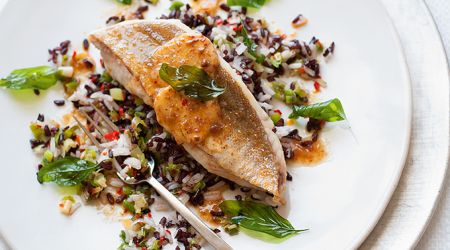Gurnard
Catch this sustainable, spiny-finned wonder now, before ringing endorsements from high- profile chefs send prices skyrocketing, says Clarissa Hyman
It is hard to consider the gurnard without its human equivalent coming to mind – the gurner. You know, those interesting folk who enjoy, sometimes even competitively, distorting their faces into ghastly grimaces. The gurnard not only shares half a name but an equally disturbing physiognomy. In other words, they look crazy and savage. However, ugly fish can make a tasty dish. Red gurnard is back on the tables at sustainable-conscious restaurants, with sales rising every year – albeit from a very low base. The days when trawlermen, catching them in their nets, just tossed them back into the sea – or they were used to bait lobster and crab – are largely no more. Today these non-quota fish from populations currently deemed to be stable offer a viable alternative to under-pressure varieties. The fact is they are surprisingly delicious and well-textured despite their prehistoric, blood-curdling appearance.
The best known, and arguably the tastiest, is the red gurnard. Its bright-red colouration and pinkish-silver mottling has led to it being called the ‘grondin rouge’ in France and the ‘Engelse soldaat’ in the Netherlands, a reminder perhaps of the uniforms their former red-coated enemies across the Channel once wore.
One of its close relations, and the smallest of the three main species, the grey gurnard sports a lot of small, pale spots and has a reddish tinge (which Alan Davidson suggests might account for its Spanish name of ‘borracho’ or drunkard). Another family member, the tub or yellow gurnard is both the largest and most colourful with bright-red pectoral fins and peacock blue and green spots and edges.
All species of gurnard have distinctive looks with armoured heads and large eyes, protected by bony plates, substantial scales and strong spines. Their large mouths give them a Donald Duck look. One immediately noticeable, and somewhat unnerving, feature is the fish’s long, thin lower rays or tentacles of the pectoral fins. These contain sensory organs used to sweep the sea bed for dinner – the small fish, crustaceans and other invertebrates that lurk in the sediment. They derive their more gentle, alternate American name of sea robin from the large pectoral fins with which they seemingly ‘fly’ through the seas.
Gurnards have another, perhaps even more disconcerting, feature: they produce sounds. The croaking noise has been compared to snoring, although I am in no position to personally verify this. They are also said to make this noise when caught. Their Scottish name, ‘crooner’, was thought by Dr Johnson to refer to this sonorous habit. It is unclear if the singing style of big band singers has any connection, as we don’t know how well the gurnards can carry a tune.
The rather alarming noise comes from a muscle that the fish uses to drum against its swim bladder, and this can be used to communicate. Smaller fish produce more sounds and ‘grunts’ than larger ones – although no one really knows what they are saying. One theory is the smaller ones compete for food by contest – presumably grunting insults at each other. The large ones seem to use brute force to knock rivals aside in the scramble for food, so it’s possible that the grunts could be sounds of both warning and triumph.
Gurnards make good eating although they are quite bony. If filleting them yourself, be careful of the spiky fins that can easily cut your hand. Be on guard, also, for pin bones near the head. But it is worth the attention as the reward for your due diligence is a fine, flavoursome fish.
The flesh is firm and white, and the fish can be baked whole or the fillets fried, grilled or poached. They are also well suited to soups and bouillabaisse-type stews as they can stand up to relatively long cooking times. Gurnard has a strong flavour, though not as strong as mackerel, for example, which matches well with earthy ingredients such as mushrooms, bacon or Jerusalem artichokes, and complements the sharpness of onions, white wine and lemon. Nor is the fish overwhelmed by the liberal use of spices.
Rick Stein sometimes serves gurnard cooked in beef dripping at his fish and chip shop in Padstow, Cornwall, and Hugh Fearnley-Whittingstall pot-roasts it whole with winter vegetables. Other chefs have looked to North Africa to pair it with sweet and sour onions, ginger and saffron, or broad beans, spinach and mint. Stephen Harris of The Sportsman restaurant in Kent makes a sensational dish of gurnard baked whole in French sel gris served with a bouillabaisse sauce and braised fennel. As he said, when writing in The Telegraph, ‘The fish tasted briny and sweet and the texture was enhanced by a slight stickiness that came from the gelatine in the fish bones’.
At one time, fried gurnard fillets were popularly marinated or soused in vinegar, and the term ‘soused gurnet’ is even spoken by Shakespeare’s Falstaff. It is a wonderfully evocative phrase, and if ever I am faced with a threatening situation, I shall simply pull a gruesome, gurning face and croak, ‘Begone you soused gurnet!’ Be afraid, be very afraid.

Recipes
Get Premium access to all the latest content online
Subscribe and view full print editions online... Subscribe




